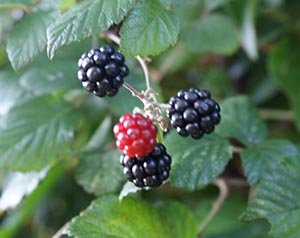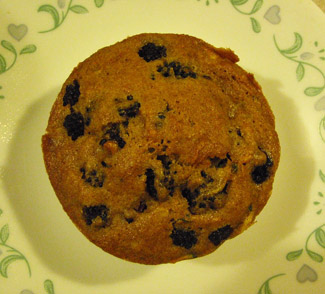Blackberries Nutrition facts
Sweet, succulent blackberries are summer delicacies in the northern temperate regions. As in raspberries, they too grow on shrubs known as "brambles." The plant is native to sub-arctic Europe and nowadays grown at a commercial scale in North America, particularly in the USA, to as far as Siberia.
Binomially, brambles are small perennial shrubs belonging to the huge Rosaceae family of bush berries, in the Genus: Rubus.
Botanical name: Rubus fruticosus.
 |
| Delicious blackberries! Photo courtesy: Andrew Michaels. |
Depending upon cultivar type, blackberry bush can be classified into erect, semi-erect, and trailing types.
Erect-type bushes generally feature cane thorns, which are spread by root suckers (send cane shoots) along the hedgerows. Whereas trailing shrubs require a trellis to support growth and spread through fresh shoots, known as canes or primocanes. During the second year, these primocanes become floricanes. White or pink flowers appear in the floricanes.
Technically, blackberry is an aggregate fruit consisting of small drupelets arranged in a circular fashion. Each drupelet is composed of juicy pulp with a single tiny seed. Each berry measures about 3-4 cm in length containing about 80-100 drupelets.
Loganberries and phenomenon-berries are hybrids between blackberry and red raspberry. Several other bramble berries such as boysenberry, ness berry, youngberry, marionberry, etc., are hybrids of dewberry, blackberry, and wild raspberry cultivars.
Health benefits of Blackberries
As in other kinds of bush berries, blackberries are also packed with phytonutrients such as vitamins, minerals, antioxidants, and dietary fibers that are essential for optimum health.
The berries are very low in calories. 100 g provides just 43 calories. Nonetheless, they are rich in soluble and insoluble fiber (100 g whole berries consist of 5.3 g or 14% RDA of fiber). Xylitol is a low-calorie sugar substitute existing in the fiber content. It is absorbed into the blood at a rate slower than glucose inside the gut. It, thus, helps in steadying blood sugar levels.
Blackberries compose significantly high amounts of phenolic flavonoid phytochemicals such as anthocyanins, ellagic acid, tannin), quercetin, gallic acid, cyanidin, pelargonidin, catechins, kaempferol, and salicylic acid. Scientific studies suggest that these antioxidant compounds may have potential health benefits against cancer, aging, inflammation, and neurological diseases.
Fresh berries are excellent sources of vitamin C (100 g of berries contain 23 mg or 35% of RDA), which is a powerful natural antioxidant. Consumption of fruits rich in vitamin C helps develop resistance against infectious agents, counter inflammation, and scavenge harmful free radicals from the human body.
They carry adequate levels of vitamin A, vitamin E, and vitamin K (16% of RDA/100 g). Further, they are rich in several other health-promoting flavonoid polyphenolic antioxidants such as lutein, zeaxanthin, and ß-carotene in small amounts. Altogether, these compounds help act as protective scavengers against oxygen-derived free radicals and reactive oxygen species (ROS) that play a role in aging and various disease processes.
Blackberries have an ORAC value (oxygen radical absorbance capacity, a measure of anti-oxidant strength) of about 5,347 µmol TE per 100 grams.
Further, blackberries contain a good amount of minerals like potassium, manganese, copper, and magnesium. Copper is required in bone metabolism as well as in the production of white and red blood cells.
They contain moderate levels of the B-complex group of vitamins. It contains good amounts of pyridoxine, niacin, pantothenic acid, riboflavin, and folic acid. These vitamins work as co-factors for enzymes that help metabolize carbohydrates, proteins, and fats in the human body.
| Principle | Nutrient Value | Percent of RDA |
|---|---|---|
| Energy | 43 Kcal | 2% |
| Carbohydrates | 9.61 g | 7% |
| Protein | 1.39 g | 2% |
| Total Fat | 0.49 g | 2% |
| Cholesterol | 0 mg | 0% |
| Dietary Fiber | 5.3 g | 14% |
| Vitamins | ||
| Folates | 25 µg | 6% |
| Niacin | 0.646 mg | 4% |
| Pantothenic acid | 0.276 mg | 5.5% |
| Pyridoxine | 0.030 mg | 2% |
| Thiamin | 0.020 IU | 2% |
| Vitamin A | 214 IU | 7% |
| Vitamin C | 21 mg | 35% |
| Vitamin E | 1.17 mg | 8% |
| Vitamin K | 19.8 µg | 16.5% |
| Electrolytes | ||
| Sodium | 1 mg | 0% |
| Potassium | 162 mg | 3% |
| Minerals | ||
| Calcium | 29 mg | 3% |
| Copper | 165 µg | 18% |
| Iron | 0.62 mg | 8% |
| Magnesium | 20 mg | 5% |
| Manganese | 0.646 mg | 3% |
| Selenium | 0.4 µg | 1% |
| Zinc | 0.53 mg | 5% |
| Phyto-nutrients | ||
| Carotene-ß | 128 µg | -- |
| Carotene-α | 0 µg | -- |
| Lutein-zeaxanthin | 118 µg | -- |
Selection and storage
Blackberry season generally lasts from June until September. Fresh berries can either be handpicked or harvested using machines in large-scale farms. In general, the berries are ready to be harvested once they come off the receptacle easily and have turned into a deep color. At that stage they are supposed to ripen well and the sweetest.
In the stores, choose fresh berries featuring bright, shiny, completely black, and plump in constancy. In general, the berries are packed in a solid box, spread out evenly in a single layer.
Avoid unripe (purple), overripe, bruised, damaged, and mushy (soft) berries. In general, the berries are highly perishable and sensitive to handling. At home, use them as soon as possible.
To store, place them in the refrigerator where they stay fresh for up to 4-5 days.
Preparation and serving methods
Fresh blackberries can be eaten out of hand directly from the bush. If you are purchasing from the stores, they are best used immediately.
To prepare, do not wash them until you are ready to use. Just rinse in a bowl of cold water, and swish around to remove any surface dirt. Gently fish them out of the water and pat dry using an absorbent towel. This method will also help revive them back to normal room temperature, increase their flavor, and enrich their taste.
Here are some serving tips:
 |
| Blackberry muffin!- Photo courtesy: faul |
-
Blackberries make a delicious addition to fruit/vegetable salads. They can be added to ice-creams.
Add pureed, and sieved to prepare juice, jams, jellies, syrup, and sorbet.
Pureed, and sieved, added in juice, jams, jellies, syrup, and sorbet preparations.
They add a special flavor to muffins, bread, pie, pastry, crumbles, tarts, and puddings.
Safety profile
Allergy to blackberries is uncommon and rare. There are only a few reported cases, particularly in some sensitized individuals. The reaction may be thought to be due to the presence of salicylic acid in the berries which, may cause symptoms like swelling and redness of mouth, lips, and tongue, eczema, hives, skin rash, headache, runny nose, itchy eyes, wheezing, gastrointestinal disturbances, depression, hyperactivity, and insomnia. Individuals who suspect an allergy to these fruits may want to avoid them. (Medical disclaimer).
≻≻-Back to Fruits from Blackberries. Visit here for an impressive list of all varieties of fruits with complete illustrations of their nutrition facts and health benefits.
≻≻-Back to Home page.
Further resources:
Growing blackberries-Department of fruit science, Missouri state university(pdf-Link opens in new window).
Stanford School of Medicine Cancer information Page- Nutrition to Reduce Cancer Risk (Link opens in new window).